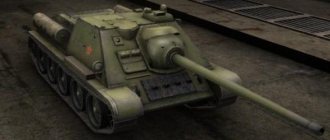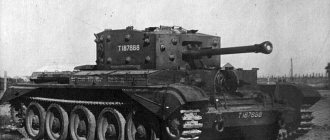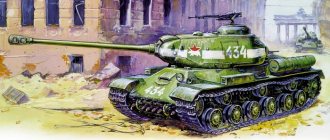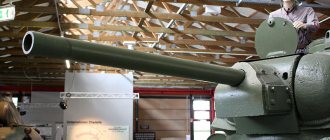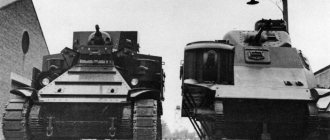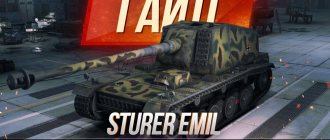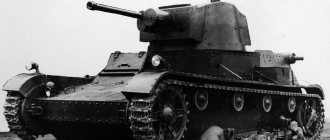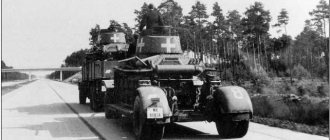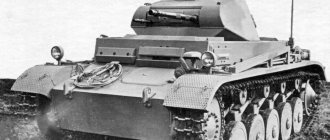History of the creation of the KV-1S heavy tank
The KV-1S is a deep modernization of the KV-1 tank with many changes and improvements. The letter "S" stands for Speed. Already in 1942, the KV tank did not live up to the expectations of commanders and crews. In addition, the Germans had new shells for the 50-mm cannon, capable of penetrating the frontal armor of the KV-1. All attempts to somehow modernize the KV-1 boiled down to a banal increase in the tank’s armor by installing additional armor plates. This “rapid modernization” reduced the already low dynamics of the tank, its maneuverability and speed.
German soldiers next to a damaged KV-1. Additional armor plates (screens) on the turret are noticeable.
In addition, the tank’s armament was practically no different from the T 34 gun, and there was a 76 mm gun in both places.
Chief Designer Zh.Ya. Kotin received a lot of comments from the command, and he was forced to go to the front to receive first-hand information in order to improve the tank in any way.
As a result of the trips, many shortcomings in the tank were revealed. Such as: heavy weight (often breaking bridges), insufficient maneuverability, frequent breakdowns, insufficiently strong weapons for a heavy tank - these are the main problems of the KV-1, and there were also many other complaints from the tank crews.
Having collected enough information, work began on modernizing the KV-1 tank.
Scheme of the KV-1S tank
KV-1S armor scheme
First, it was necessary to lighten the tank by reducing the height of the hull, changing the gearbox, replacing the tracks with narrower ones, reducing the turret, and reducing the thickness of the armor of the hull and turret.
All this resulted in a reduction in combat weight to 42.5 tons. However, the problem with weapons was never solved, because By that time, the designers had not been able to develop a new tank gun of a larger caliber. Well, later, as a result of small tests in November, KV-1S tanks entered service with the army.
A total of 1,106 KV-1S tanks were produced. Production ceased in September 1943 due to the introduction into service of the army of the Third Reich of the Tiger tanks, the Ferdinand tank destroyer and the Nashorn self-propelled gun (PzKpfw IV) armed with powerful 88-mm cannons, which immediately put the KV- 1C, because maneuverability alone was clearly not enough to fight such powerful tanks.
Tang "Tiger" next to a damaged KV-1S.
But, despite this, KV-1S tanks were in service with the Soviet troops until 1945. By the way, there were practically none left then. At the moment, only one original sample of the KV-1S tank remains. It is located in the village of Parfino, Novgorod region.
gun
In terms of armament, our tank is also very interesting. The fact is that the KV-1S gun is available in two copies, each of which has every right to life.
In the first case, it is a gun with a caliber of 85 millimeters, which is quite standard. It has good parameters for armor penetration, one-time damage, acceptable accuracy and a fairly decent DPM of 1920 damage. It is comfortable to play with this weapon, and anyone can do it.
However, there is a second barrel with a diameter of 122 millimeters - a high explosive. As you may have guessed, in this case we will have to shoot with landmines, and the weapon itself has mediocre accuracy, takes a long time to reload, but with one shot it can inflict a huge amount of damage, provided that the landmine penetrates the target’s armor. Frankly speaking, you will have a lot of fun if you load gold shells here, as it is an indescribable feeling to kill a weaker or low-level enemy with one shot. Conventional projectiles also have a right to life, but with them you will only feel comfortable at the top of the list.
Among the shortcomings of the KV-1C World of Tanks armament, we can only note the poor gun depression angles - only 5 degrees down, this often causes a lot of inconvenience.
Armament of the KV-1S tank
Compared to the KV-1 tank, it has not changed at all; the same 76-mm ZiS**-5 gun remains.
- Weight of gun, kg – 455
- Ammunition, sn. — 90, later 114
- Rate of fire, rds/min – From 4 to 8
- Initial flight speed of an armor-piercing projectile, m/s, - 662
- Initial flight speed of a sabot projectile, m/s, - 950
- Initial flight speed Oskol.-High-explosive. projectile, m/s, - 680
- Maximum flight range Oskol.-High-explosive. projectile, m – 1329
- Sighting range, m, — 1500
- Vertical aiming angles, degrees: -5°…+25°
Armor penetration of the gun
- Armor-piercing, At a distance of 500 m, mm/deg. — 84/90°
- Armor-piercing, At a distance of 1.5 km, mm/deg. — 69/90°
Additional weapons
Three DT machine guns, 7.62 mm caliber. One is a coaxial machine gun, another is a course machine gun mounted in the front of the hull, and the third is installed in the rear of the turret.
About production
Design work was carried out in the design bureau of the tractor plant in the city of Chelyabinsk. Soon a prototype tank with a 650 hp V-2K engine was ready. With. and new final drives. However, during testing it turned out that the power unit was ineffective. The opposite situation was observed with final drives, which it was decided to leave. Later, their serial production was established. In April, they tested a new gearbox designed for 8 speeds and a 700 hp engine. With. According to experts, it was not possible to fully test the engine, and the KV-1S tank soon began to be equipped with a gearbox. In total, the Soviet defense industry produced 1,120 combat units.
Tactical and Technical Characteristics of the KV-1S
- Weight, t - 43
- Crew, h - 5. Commander, Gunner, Loader, Mechanic-Driver, Gunner-Radio Operator.
- Case length, mm — 6900
- Case width, mm — 3250
- Height, mm — 2640
Booking KV-1s
- Body forehead (top), mm/deg. — 40/65° and 75/30°
- Body forehead (bottom), mm/deg. — 75/−30°
- Hull side (top), mm/deg. — 60/0°
- Hull side (bottom), mm/deg. — 60/0°
- Hull stern (top), mm/deg. — 40/35°
- Hull rear (bottom), mm/deg. — 75/cyl.
- Bottom, mm - 30
- Housing roof, mm - 30
- Gun mask, mm/deg. — 82
- Tower side, mm/deg. — 75/15°
- Tower roof, mm - 40
Running quality
- Engine power, l. With. — 600
- Maximum speed, km/h - 42
- Cruising range on the highway, km - 180
- Specific power, l. s./t - 14.1
- Climbability, degrees. — 36°
Acquaintance
The KV-1S tank (a photo of the combat unit can be seen below) is one of the models of heavy armored vehicles produced by the defense industry of the USSR. Soviet heavy tanks produced from 1940 to 1943 are designated by the abbreviation KV. What does the Klim Voroshilov 1C mean in the tank? This index indicates that the combat unit is fast and the first model of the entire series of tanks.
About the power unit
The tank used a four-stroke V-shaped 12-cylinder diesel engine V-2K. The engine power was 600 horsepower. To start the unit there was an ST-700 starter (15 hp). Also for this purpose, compressed air was used, contained in two 5-liter tanks in the combat compartment. The volume of the main fuel tanks was 600 and 615 liters. Their location was the combat and transmission compartments. Additionally, the tank had four more external fuel tanks that were not connected to the general system. Each container is designed for 360 liters of fuel.
Inside a Soviet high-speed tank
The driver's workplace is the front part of the hull in the center. The radio operator gunner is to his left. A combat crew of three people was housed in the turret. The gunner and vehicle commander sat to the left of the gun, and the loader to the right. The commander had a cast observation turret, the armor of which was 6 cm thick. For the landing and exit of the combat crew, two round hatches were provided in the tank. One of them was under the loader, the second was in the top cover of the housing above the gunner-radio operator. In addition, the KV-1S was equipped with a bottom emergency hatch. Repair of components and assemblies of the machine was carried out through additional small technical hatches. Through them it was possible to get to the fuel tanks, as well as load ammunition into the tank.
About the chassis
In the design of this unit, the developers used the chassis from the KV-1. However, in order to reduce the overall weight of the combat vehicle, the dimensions of some parts still had to be reduced. The KV-1S came with an individual torsion bar suspension provided for each solid-cast gable road wheel. There are 6 of them in total on each side. The diameter of the skating rink was 60 cm. The defense industry of the USSR produced two types of skating rinks: with round holes and triangular ones. The first type was the most common. Each roller was equipped with a travel limiter, which was welded to the armored hull.
The chassis of the tank is with lantern gear and removable rims. The caterpillar tension was carried out using a special screw mechanism. The caterpillar was equipped with 86 single-ridge tracks. Unlike the base model, the track width in the high-speed tank was 60 cm.
Order of studying modules:
| Chassis | Tower | gun | gun | Engine | Radio station | Radio station | |
| Result: Experience: 27880 Credits: 173550 | |||||||
| KV-1S arr. 1943 | KV-122 mod. 1944 | 122 mm howitzer S-41 | 85 mm S-31 | V-2IS | 10R | 10RK | |
| 2450 experience - 10390 credits | 2650 experience - 10500 credits | 3720 experience - 45200 credits | 4350 experience - 49200 credits | 11,000 experience - 36,000 credits | 610 experience - 3660 credits | 3100 experience - 18600 credits |
More details on the research.
- Chassis KV-1S arr. 1943 - will add carrying capacity and also increase the maneuverability of the tank.
- Tower KV-122 arr. 1944 - increases armor, visibility range and will allow the installation of more powerful weapons.
- The 122 mm howitzer S-41 gun has high one-time damage, but in other respects it is inferior to the 85 mm S-31.
- The 85 mm S-31 gun has high accuracy, rate of fire and penetration.
- The V-2IS engine significantly increases dynamics.
- Radio stations 10Р and 10РК - increase communication range.
About surveillance equipment and sights
According to experts, of all the large-scale Soviet tanks, the high-speed KV-1S is considered the first to use a commander's cupola equipped with viewing slits. There were 5 of them in total, and they were covered with protective glass. The driver had a viewing device. To protect the triplex there was a special armored flap. The location of this device was a plug hatch in the front part of the tank. In a non-combat situation, the driver could move this hatch a little forward to view a larger area. The KV-1S used two gun sights: the telescopic TOD-6, which provided direct fire, and the periscopic PT-6. It was used if it was necessary to shoot from a closed position. PT-6 was protected by a special armored cap. Thanks to the illumination devices that were equipped with the sight scales, firing was possible at night. The forward and rear DT machine guns were equipped with sighting devices used in sniper rifles. Each such sight provided threefold magnification.
About communications
To communicate between the combat crew and the command, the KV-1S was equipped with a 9R radio station and a TPU-4-BIS intercom. It could be used by four subscribers. The tanks were also equipped with 10Р or 10РК radio stations. The kit included a transmitter, receiver and umformer. The latter was a single-anchor motor-generator, through which the stations were powered from the on-board 24 V electrical network. According to experts, in telephone mode communication was provided at a distance of 20 to 25 thousand m. While the tank was moving, the communication range was lower. TPU-4-Bis was used for negotiations inside the tank. If the situation was too noisy, the crew could use a headset, which was also connected to external radio communications.
About armor protection and a tank turret
In the production of the high-speed tank “Klim Voroshilov” (a photo of this combat unit can be seen in the article), rolled armor plates were used, the thickness of which was 2, 3, 4, 6 and 7.5 cm. The vehicle had differentiated ballistic armor protection. The turret in the tank has a complex, streamlined shape and was made by casting. In order to increase its projectile resistance, the designers positioned the side of the tower at an angle of 75 degrees in the vertical plane. The sides, according to experts, had the greatest thickness - 75 mm. An embrasure for a cannon was also placed in the frontal part of the tower. This part was cast separately. Then they were connected to the rest of the armored parts by welding. The gun mantlet was made on the basis of a rolled armored plate, which was bent and equipped with three holes for a cannon, a coaxial machine gun and a sight. The result was a product in the form of a cylindrical segment with a thickness of 8.2 cm. The turret was placed on the cover in the fighting compartment on a shoulder strap, the diameter of which was 153.5 cm. To prevent it from falling off when the tank rolled strongly, it was securely fixed with special grips.
Experts' opinion
According to military experts, the design of the KV-1S was a response to failures in the first stage of the war. Immediately after serial production was established, the tanks were transferred to the front. During the fighting, the Red Army command noted that the armor in the high-speed KV-1 was not enough to withstand the standard shells used by the T-3 and T-4. These tanks penetrated the KV-1S from a distance of 200 m.
In addition, the cross-country maneuverability of this combat vehicle left much to be desired. There were also complaints regarding the reliability of the transmission. If we consider the firepower of the KV-1S, it was enough to destroy a fascist tank from a distance of 200 m. Improvement at the front was observed until the Germans began producing Tigers and Panthers. Of course, the KV-1S could destroy such a tank, but due to the insignificant caliber of the main gun, the Soviet crew had to get close to the fascist armored vehicles to do this. A projectile from the KV-1S penetrated Tigers and Panthers from a distance of less than 200 m.
Tanks of the Anti-Hitler CoalitionSoviet tanks
T-28, 1933
Combat weight – 25.4 tons. Crew – 6 people. Reservation – 10-30 mm. Armament: 1x76.2 mm KT-28, 4x7.62 mm machine gun. Engine power – 500 hp. Speed on the highway is 42 km/h. Circulation – 503 pcs. Read the article about him →
26 gun single turret, 1933
Combat weight – 9.4 tons. Crew – 3 people. Armament – 45-mm tank gun 20K mod. 1932 and a 7.62 mm machine gun, armor thickness: forehead, side, rear and turret - 13 mm; roof – 10 mm; bottom – 6 mm. Engine – 90 l. With. Speed on the highway is 30 km/h. Cruising range on the highway is 130 km. Read the article about him →
BT-5, 1933
Combat weight – 11.5 tons. Crew – 3 people. Armament - one 45-mm tank gun 20K mod. 1932, one 7.62 mm machine gun. The thickness of the armor - forehead, side of the hull and turret - 13 mm. Engine – aviation M-5, 400 hp. With. Highway speed – 52 km/h on tracks, 72 km/h on wheels. Circulation – 1884 pcs. Read the article about him →
T-37A, 1935
Combat weight – 3.2 tons. Crew – 2 people. Armament - 1 machine gun. The thickness of the armor is 9 mm on the forehead and side of the hull. Engine – GAZ-AA, 40 l. With. Speed on the highway - 36, afloat 6 km/h. Read the article about him →
T-35, 1935
Combat weight - 50 tons. Crew - 11 people. Body length – 9720 mm, Width – 3200 mm, Height – 3430 mm, Ground clearance – 530 mm. Armament - one 76.2 mm KT-28, two 45 mm tank guns mod. 1932 20K, 6 machine guns. Reservations: hull front – 50 mm, side – 20 mm, turret – 20 mm. Engine – M17, 500 hp. With. Speed on the highway is 30 km/h. Circulation – 61 pcs. Read the article about him →
38, 1936
Combat weight – 3.3 tons. Crew – 2 people. Armament: one 7.62 mm machine gun. Reservations: forehead, hull side and turret – 9 mm, bottom – 4 mm. Engine – carburetor GAZ-AA, 40 l. With. Speed on the highway is 40 km/h, on water – 6 km/h. Cruising range on the highway is 200 km. Read the article about him →
T-29, 1936
Combat weight – 28.5 tons. Crew – 5 people. Reservation – 30–10 mm. Length – 6530 mm. Width – 3055 mm. Height – 2850 mm. Ground clearance – 450 mm. Armament: 1x76.2 mm KT-28, 4x7.62 mm machine gun. Engine power – 500 hp. Highway speed – 56 km/h on tracks, 81 km/h on wheels. Circulation – 8 pcs. Read the article about him →
BT-7, 1937
Combat weight - 13.8 tons. Crew - 3 people, armament - one 45-mm tank gun 20K mod. 1932, one or two 7.62 mm machine guns. Armor thickness: hull front – 20 mm, side – 13 mm, turret – 15 mm. Engine – petrol M17T, 400 l. With. Speed on the highway is 52-73 km/h. Cruising range on the highway is 350-500 km (with additional tanks). Read the article about him →
BT-7A, 1937
Combat weight - 13.8 tons. Crew - 3 people, weapons - one 76-mm KT-26 cannon, two 7.62-mm machine guns. Armor thickness: hull front – 20 mm, side – 13 mm, turret – 15 mm. Engine – petrol M17T, 400 l. With. Speed on the highway is 50-73 km/h. Cruising range on the highway is 350-500 km (with additional tanks). Circulation – 154 pcs. Read the article about him →
BT-7M, 1939
Combat weight - 14.65 tons. Crew - 3 people, armament - one 45-mm tank gun 20K mod. 1932, one or two 7.62 mm machine guns. Armor thickness: hull front – 20 mm, side – 13 mm, turret – 15 mm. Engine – diesel B2, 500 l. With. Highway speed – 62 km/h on tracks, 86 km/h on wheels. Cruising range on the highway is 350-500 km (with additional tanks). Circulation – 706 pcs. Read the article about him →
T-40, 1939
Combat weight – 5.5 tons. Crew – 2 people. Armament: one 12.7 mm DShK machine gun, one 7.62 mm machine gun. Reservations: front and side of the hull – 13 mm, turret – 10 mm. Engine GAZ-11, 85 l. With. Speed on the highway is 44 km/h (5 km/h afloat). Cruising range on the highway is 220 km. Read the article about him →
KV-1, 1940
Combat weight – 43.1 tons. Crew – 5 people. Armament: one 76.2 mm L-11 cannon, three 7.62 mm machine guns. Armor thickness: hull front - 75 mm, side - 60 mm, turret - 82 mm. Engine – diesel V-2, 500 hp. With. Speed on the highway is 36 km/h. Cruising range on the highway is 230 km. Read the article about him →
KV-2, 1940
Combat weight – 52 tons. Crew – 6 people. Armament: one 152 mm M-10 gun, three 7.62 mm machine guns. Armor thickness: forehead, hull side and turret - 75 mm. Engine – V-2K, 600 hp. With. Speed on the highway is 35 km/h. Cruising range on the highway is 250 km. Circulation – 434 pcs. Read the article about him →
T-34, 1939
Combat weight – 26.5 tons. Crew – 4 people. Armament - one 76.2 mm L-11 cannon (since 1941 - F-34), two 7.62 mm machine guns. Armor thickness: forehead and side of the hull – 45 mm, turret – 45 mm. Engine – diesel V-2, 500 hp. With. Maximum speed – 55 km/h. Cruising range – 370 km. Read the article about him →
T-50, 1941
Combat weight – 13.5 tons. Crew – 4 people. Armament - one 45-mm tank gun 20K mod. 1932, one 7.62 mm machine gun. Armor thickness: hull and turret – 37 mm. Engine – diesel V-6, 300 hp. With. Speed on the highway is 60 km/h. Cruising range on the highway is 340 km. Circulation – 75 pcs. Read the article about him →
T-34-57, 1941
Combat weight – 26 tons. Crew – 4 people. Armament - one 57-mm ZiS-4 cannon (since 1943 - ZiS-4M), two 7.62-mm machine guns. Armor thickness: front and side of the hull - 45 mm, front of the turret - 52 mm. Engine – diesel V-2, 500 hp. With. Maximum speed – 55 km/h. Power reserve – 300 km. Read the article about him →
NI-1, 1941
Combat weight ~ 7 tons. Crew – 2-3 people. Armament - light gun, caliber 37-45 mm, 2 × 7.62 mm. Armor thickness: hull front – 20 mm, side – 10 mm, turret – 20 mm. Engine - multi-fuel four-cylinder carburetor 1MA, 52-56 liters. With. Speed on the highway is 20 km/h. Cruising range on the highway is 140 km. Circulation – 62 pcs. Read the article about him →
T-60, 1941
Combat weight – 5.8 tons. Crew – 2 people. Armament: one 20-mm TNSh cannon, one 7.62-mm machine gun. Armor thickness: hull front – 35 mm, side – 15 mm, turret – 15 mm. Engine – GAZ 202. 70 l. With. Speed on the highway is 42 km/h. Cruising range on the highway is 450 km. Circulation – 5920 pcs. Read the article about him →
T-70, 1942
Combat weight – 9.8 tons. Crew – 2 people. Armament - one 45-mm tank gun 20K mod. 1932, one 7.62 mm machine gun. Armor thickness: forehead 35-45 mm, turret - 35 mm, gun mantlet - 65 mm, side - 15 mm, rear - 25 mm, roof, bottom -10 mm. Engine – 2×GAZ 202. 140 l. With. Speed on the highway is 45 km/h. Cruising range on the highway is 350 km. Circulation – 8231 pcs. Read the article about him →
KV-1s, 1942
Combat weight – 42.5 tons. Crew – 5 people. Armament: one 76.2 mm F-34 cannon, three 7.62 mm machine guns. Armor thickness: hull front – 75 mm, side – 40 mm, turret – 82 mm. Engine – diesel V-2K, 600 l. With. Speed on the highway is 42 km/h. Cruising range on the highway is 250 km. Circulation – 2769 pcs. Read the article about him →
T-80, 1943
Combat weight – 11.6 tons. Crew – 3 people. Armament - one 45-mm tank gun 20K mod. 1932, one 7.62 mm machine gun. Armor thickness: hull front – 45 mm, side – 25 mm, turret – 35 mm. Engine - two GAZ 80 85 liters each. With. Speed on the highway is 45 km/h. Cruising range on the highway is 360 km. Circulation – 85 pcs. Read the article about him →
KV-85, 1943
Combat weight – 46 tons. Crew – 4 people. Armament: one 85-mm D5 cannon, three 7.62-mm machine guns. Armor thickness: hull front – 75 mm, side – 60 mm, turret – 100 mm. Engine – diesel V-2K, 600 l. With. Speed on the highway is 42 km/h. Cruising range on the highway is 330 km. Circulation – 148 pcs. Read the article about him →
IS-1, 1943
Combat weight – 44 tons. Crew – 4 people. Armament: 85 mm D5 tank gun and 3 machine guns. Armor thickness: hull front – 100 mm, side – 90 mm, turret – 100 mm. Speed on the highway is 37 km/h. Cruising range on the highway is 120 km. Circulation – 107 pcs. Read the article about him →
T-34-85, 1944
Combat weight – 32 tons. Crew – 5 people. Armament: one 85 mm cannon, two 7.62 mm machine guns. Armor thickness: front and side of the hull – 45 mm, turret – 90 mm. Engine – diesel V-2, 500 hp. With. Maximum speed – 55 km/h. Cruising range – 420 km. Read the article about him →
IS-2, 1943
Combat weight – 46 tons. Crew – 4 people. Armament: one 122 mm cannon, three 7.62 mm machine guns. Armor thickness: hull front – 120 mm, side – 90 mm, turret – 100 mm. Engine – diesel V-2IS, 520 hp. With. Speed on the highway is 37 km/h. Power reserve – 220 km. Circulation – 3385 pcs. Read the article about him →
T-44, 1945
Combat weight – 31.5 tons. Crew – 4 people. Armament: one 85 mm cannon, two 7.62 mm machine guns. Armor thickness: hull forehead – 120 mm. Engine – V-44, 520 hp. With. Maximum speed – 51 km/h. Circulation – 1823 pcs. Read the article about him →
IS-3, 1945
Combat weight – 47 tons. Crew – 4 people. Armament: one 122 mm cannon, one 7.62 mm machine gun, one 12.7 mm anti-aircraft machine gun. Armor thickness – front of the hull – 120 mm, side – 90 mm. Engine – diesel, V-11IS 520 l. With. Speed max. – 40 km/h. Cruising range on the highway is 200 km. Circulation – 2311 pcs. Read the article about him →
Polish tanks
TKS
Combat weight – 2.65 tons. Crew – 2 people. Armament - 1 machine gun. The thickness of the armor is 8–10 mm on the forehead and side of the hull. Engine – “Polish Fiat” 42 hp. With. Speed on the highway is 40 km/h. Cruising range on the highway is 180 km.
7TP
Combat weight – 9.9 tons. Crew – 3 people. Armament: one 37 mm cannon, one 7.92 mm machine gun. Armor thickness: hull front – 17 mm, side – 13 mm, turret – 15 mm. Engine – diesel Saurer VBLD 110 l. With. Speed on the highway is 32 km/h. Cruising range on the highway is 160 km. Read more →
Belgian tanks
T-13
T-15
American tanks
M3 Stewart
Combat weight - 12.7 tons. Crew - 4 people. Armament: one 37 mm cannon, three 7.62 mm machine guns. Armor thickness: hull front - 43 mm, side - 25 mm, turret - 38 mm. Engine - diesel Giberson T1020-M, 220 hp. With. Speed on the highway is 57 km/h. Cruising range on the highway is 110 km. Read more →
M3 Lee/Grant
Combat weight – 27 tons. Crew – 7 people. Armament: one 75 mm and one 37 mm cannon, four 7.62 mm machine guns. Armor thickness: hull forehead – 51 mm, side – 38 mm. tower – 57 mm. Engine – Continental R975EC2, 340 hp. With. Speed on the highway is 42 km/h. Read more →
M4 Sherman
Combat weight - 32.5 tons, crew - 5 people, armament - 76-mm tank gun, 2 machine guns, one large-caliber anti-aircraft machine gun, armor - 38-63 mm, highway speed - 48 km/h. Circulation – 48071 pieces. Read more →
English tanks
Crusader
Combat weight - 19.7 tons. Crew - 3 people. Armament: one 57 mm cannon, one 7.92 mm machine gun, one 7.7 mm anti-aircraft machine gun. Armor thickness: hull front and turret – 52 mm, side – 45 mm. Engine – “Liberty III”, 345 hp. With. Speed on the highway is 48 km/h. Cruising range on the highway is 160 km. Tetrarch
Combat weight – 7.62 tons. Crew – 3 people. Armament: one 40 mm cannon, one 7.92 mm coaxial machine gun. Armor thickness: forehead - hull - 16 mm, side - 14 mm, turret - 4-16 mm. Engine – Meadows MAT, 12-cylinder, horizontally opposed, carburetor; power 165 hp Speed on the highway is 64 km/h. Cruising range on the highway is 224 km. Read the article about him →
Matilda I
Combat weight – 11.2 tons. Crew – 2 people. Reservation: forehead and side of the hull - 60 mm. Bottom and stern 20 mm, roof – 12 mm. Hull side – 60 mm. Armament: 1 × 7.7 mm or 12.7 mm Vickers machine gun. Engine – V-shaped 8-cylinder carburetor “Ford” 70 hp. With. Speed on the highway is 13 km/h. Cruising range on the highway is 128 km. Circulation – 139 pcs.
Matilda II
Combat weight - 26.5 tons, crew - 4 people, armament - 40 mm cannon and 1 machine gun, armor - 40-78 mm, highway speed - 24 km/h. Circulation – 2987 pieces.
Valentine
Combat weight - 16 tons. Crew - 3 people. Armament is one 40 mm cannon, one 7.92 mm coaxial machine gun and one 7.7 mm anti-aircraft machine gun. Armor thickness: hull front - 60 mm, side - 30-60 mm, turret - 65 mm. Engine - diesel AEC A190, 131 hp. With. Speed on the highway is 24 km/h. Cruising range on the highway is 145 km.
Read the article about him →
Churchill
Combat weight – 45 tons. Crew – 5 people. Armament: 1 x 75 mm Mk V cannon, 2 x 7.92 mm machine guns. 1x7.69 mm anti-aircraft machine gun. Ammunition - 82 shells and 6525 rounds. Reservation: hull front - 152 mm, turret front - 152 mm. Engine - carburetor "Bedford", 350 hp. Maximum speed – 28 km/h. Cruising range on the highway is 200 km.
French tanks
Combat weight – 68 tons. Crew – 13 people. Armament: one 75 mm gun, four machine guns. Reservations: hull front – 30 mm, side – 22 mm, turret – 37 mm. Two Maybach engines of 250 hp each. With. Speed on the highway is 13 km/h. Cruising range on the highway is 100 km.
Combat weight – 5 tons. Crew – 2 people. Armament: 1 × 7.5 mm Reibel m1931. Armor thickness: hull front - 13 mm, side and rear - 5 mm. Engine – carburetor Reinstella 82 liters. With. Speed on the highway is 60 km/h. Cruising range on the highway is 200 km. Circulation – 123 pcs.
IN 1
. Combat weight – 32 tons. Crew – 4 people. Armament: one 75 mm gun, one 47 mm cannon, two 7.5 mm machine guns. Armor thickness: front and side of the hull - 60 mm, turret - 56 mm. Engine: Renault carburetor, 300 hp. With. Speed on the highway is 28 km/h.
S-35
.
Combat weight – 20 tons. Crew – 3 people. Armament: one 47 mm cannon, one 7.5 mm. machine gun. Armor thickness: hull front - 36 mm, side - 41 mm, turret - 56 mm. Engine – SOMUA, 190 l. With. Speed on the highway is 37 km/h. Cruising range on the highway is 260 km. More details →
D-2. Combat weight – 20 tons. Crew – 3 people. Armament: one 47 mm cannon, two 7.5 mm machine guns. Armor thickness – 20-40 mm. Engine "Renault", 150 liters. With. Speed on the highway is 23 km/h. Cruising range on the highway is 155 km.
N-35 Combat weight - 11.4 tons. Crew - 2 people. Armament: one 37-mm cannon, one 7.5-mm machine gun. Armor thickness: hull front - 34 mm, side - 34 mm, turret - 45 mm. Engine - Hotchkiss, 75 liters. With. Speed on the highway is 28 km/h. Cruising range - 129 km
and R-35. Combat weight - 9.8 tons. Crew - 2 people. Armament: one 37-mm cannon, one 7.5-mm machine gun. Armor thickness: hull front - 32 mm, side - 40 mm, turret - 45 mm. Engine - Renault, 82 liters. With. Highway speed is 19 km/h, range is 138 km.
